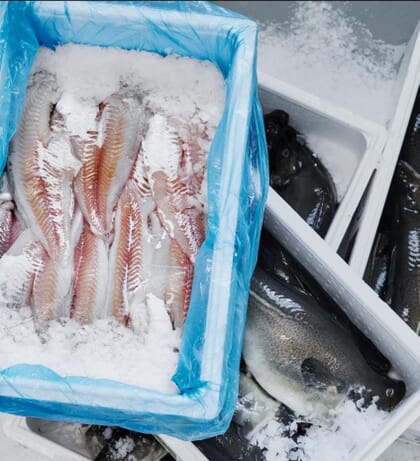
© Norcod
The chefs that took part in the interviews had between 15 and 26 years of experience preparing seafood in a professional context, but none of them had previously worked with farmed cod.
“They were each sent a crate of fifth generation farmed cod from Nofima’s facility at Ringvassøya on the outskirts of Tromsø. Each crate contained approximately 25 kilograms of farmed cod. The fish were gutted and each weighed 3 to 4 kilograms. The chefs received the fish only a few hours after they were slaughtered,” explained Morten Heide, market researcher at Nofima, in a press release.
He has led the recent report on farmed cod, which was compiled by 11 Nofima scientists.
The evaluation of farmed cod by the chefs in Tromsø showed that the quality of whole fish, fillets and when cooked was generally perceived as good or very good.
“However, the chefs had divided opinions on farmed fish and would prefer to serve wild-caught fish. Nevertheless, several of the restaurants had farmed species on their menu, including Arctic char, trout, salmon, halibut and turbot,” said Heide.
The results of the quality test are similar to those of the tests carried out on the first generation of farmed cod 19 years ago. Back then, most chefs were also of the opinion that the farmed cod was of good or very good quality.
All the chefs involved in the study were asked to evaluate the fish as gutted whole, filleted and as a cooked product. In addition, they were asked to complete a questionnaire about different product attributes, both of the fish and of a more general nature.
“In this year’s investigation, several of the chefs requested information about the farmed cod. They believed that more information could help them make qualified choices about whether or not to put farmed cod on the menu. Important factors are the content of the feed and sustainability, which will provide content to the story. Knowing the story was an important factor for all the chefs,” said Heide.
Similar to the 2002 survey, a minority of the chefs were of the opinion that farmed cod had a ‘neutral’ taste.
“This type of investigation is unable to determine whether this is due to the chef’s own preferences, that the farmed cod was very fresh, or that there is a real taste difference between wild and farmed cod,” said Heide.
Several of the chefs stated that farmed cod of a similar quality to the fish used in the test could be interesting to use outside the winter season. Currently, they only have fresh cod on the menu every now and again during the rest of the year.
“Most chefs said they would have cod on the menu more often if availability and quality were good,” said Heide.
The chefs believe that consistently high quality, good availability and deliverability are arguments that justify a good price for cod.
“A small majority were of the opinion that the price of farmed cod should be slightly lower than wild cod. This corresponds to the previous test carried out on farmed cod,” said Heide.
The chefs’ main purchasing criteria were:
- Quality, both texture and when the fish were caught/slaughtered
- Availability and season
- Size
- Type of product (pure loin of the correct size, whole fillets with skin on or other requirements)
- Price in relation to quality
